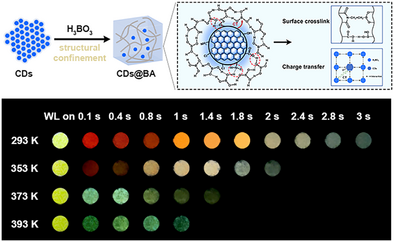Visible Light Excited Time-Dependent Phosphorescence Color Tuning in Carbon Dots via Charge Transfer
Graphical Abstract
We reported the discovery of confining carbon dots (CDs) into boric acid matrix realizing the precise regulation of color from red to white with delay time increase under white light (WL) excitation. And composites can emit persistent afterglow at high temperatures up to 393 K under WL excitation. Its time-dependent phosphorescence color (TDPC) and high stability lay a solid foundation for higher-order cryptographic and anticounterfeiting.
Abstract
Achieving high-efficiency time-dependent phosphorescence color (TDPC) materials that can be activated under visible light with strong stability remains challenging. In this study, carbon dots (CDs) were confined in the boric acid matrix to activate surface crosslinking emissive clusters and modulate charge transfer (CT) interaction, facilitating green and red dual emissive centers to coexist in composites. The presence of halogen atoms strengthened the interactions between CDs and boric acid. Notably, the CT interaction can offer excitons at low energy levels and allow for a much lower energy requirement for charge separation, making the red emissive center more dominant under visible light excitation. The interplay of dual centers featuring sufficient color differentiation and different decay rates activated characteristic TDPC evolution resulting in dynamic afterglow evolution from red to white under visible light excitation. Moreover, the formation of rigid boric acid crystalloid network resulted in an ultra-strong confinement at high temperature, enabling the composites to emit long persistent afterglow at high temperatures of up to 393 K under visible light excitation. The study provides new light on the design of TDPC materials and represents a significant advancement toward expanding the application in information security.
Conflict of Interests
The authors declare no conflict of interest.
Open Research
Data Availability Statement
The data that support the findings of this study are available from the corresponding author upon reasonable request





